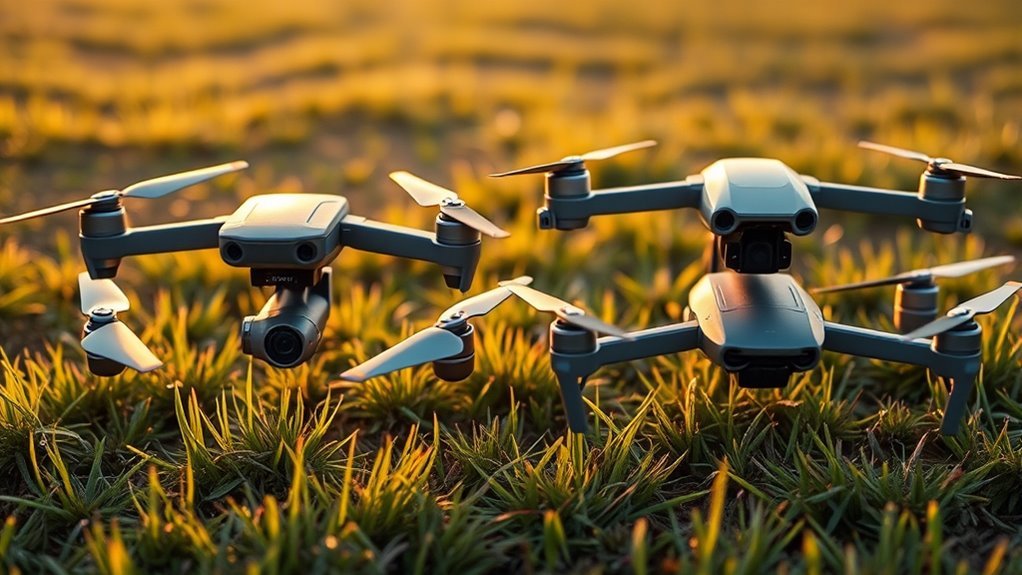When you’re choosing between the DJI Mini 3 and HoverAir X1 Pro Max for lightweight selfies, the DJI’s 10km O3 transmission trumps the HoverAir’s 500m Wi-Fi, offering superior range and stability for adventurous captures. You’ll appreciate DJI’s better flight performance, ergonomic design, and 4K camera over HoverAir’s quicker maneuvers and simpler 1080p setup. These factors make DJI more versatile, while insights into portability and user experience wait just ahead.
Design and Portability Comparison
While both the DJI Mini 3 and HoverAir X1 Pro Max prioritize portability, you’ll notice key differences in their designs that affect everyday use. The DJI Mini 3 boasts a sleek, foldable structure with balanced weight distribution, making it easier for you to handle during spontaneous adventures without feeling top-heavy. This design enhances your freedom to explore, as its even weight spread minimizes fatigue when carrying or storing it on the go.
In contrast, the HoverAir X1 Pro Max emphasizes aesthetic appeal with its compact, streamlined form, appealing to those who value a modern, unobtrusive look for quick selfies or casual flights. However, its weight distribution leans more toward the center, which can make it feel bulkier in your hand compared to the DJI’s lighter feel. Ultimately, these factors let you choose based on whether you prefer subtle elegance or ergonomic balance, empowering your aerial pursuits with designs that align with your desire for unrestricted mobility. As the drone market continues to grow at an estimated 15-20% annually, both models cater to users looking for budget-friendly options in a competitive landscape.
Flight Performance and Range Analysis
Shifting from design considerations, the DJI Mini 3 excels in flight performance with its advanced stabilization and wind resistance, allowing you to capture smooth footage even in moderate conditions, while the HoverAir X1 Pro Max offers quicker acceleration for agile maneuvers but may struggle in gusty winds. In range analysis, you’ll appreciate the DJI Mini 3’s 10km O3 transmission, providing the freedom to venture farther with reliable control, compared to the HoverAir X1 Pro Max’s 500m Wi-Fi limit, which suits closer, spontaneous flights. Battery efficiency is a standout for the DJI, delivering longer endurance that extends your exploration time, whereas the HoverAir’s quicker drain might curb extended sessions. Altitude stability further differentiates them; the DJI maintains precise, effortless hovering for steady ascents, empowering you to navigate open skies confidently, while the HoverAir can waver, potentially limiting your aerial freedom in variable conditions. Overall, these factors highlight the DJI’s edge for unrestricted adventures. Additionally, the DJI Mini 3’s design tweaks, such as streamlined airframes, contribute to improved energy efficiency, maximizing your time in the air.
Camera Features and User Experience
The DJI Mini 3’s camera delivers 4K video resolution with robust stabilization, enabling you to record crisp, smooth footage in various conditions, while the HoverAir X1 Pro Max features a 1080p setup that’s more compact and user-friendly for spontaneous captures. When evaluating camera quality, you’ll appreciate the DJI’s superior detail and dynamic range for professional-grade results, but the HoverAir’s lighter design frees you from bulky gear, ideal for quick adventures. It’s all about balance: DJI offers advanced features like HDR and slow-motion for enhanced creativity, whereas HoverAir prioritizes simplicity with its intuitive controls.
Regarding user interface, DJI’s app provides in-depth settings that let you fine-tune shots with precision, empowering your aerial storytelling without limits. In contrast, HoverAir’s streamlined interface guarantees effortless operation, so you’re not bogged down by complexity—perfect for on-the-go freedom. Ultimately, camera quality and user interface define your experience; DJI suits those seeking high-fidelity outputs, while HoverAir delivers unobstructed, liberating ease. Additionally, the DJI Mini 3’s advanced shake reduction techniques ensure that your footage remains stable even in dynamic environments. Weigh these against your needs for the ultimate airborne freedom.
Frequently Asked Questions
How Much Do These Drones Cost?
You’re wondering how much these drones cost, a key aspect of drone pricing that involves budget considerations for your aerial freedom. Typically, the DJI Mini 3 ranges from $400 to $500, while the HoverAir X1 Pro Max is priced at $300 to $400. This analysis helps you weigh options objectively, ensuring you select a model that fits your needs without straining finances.
What Accessories Come With Each Drone?
Like a key releasing new skies, accessories are essential for enhancing your drone experiences. When you immerse yourself in an accessory comparison, you’ll find the DJI Mini 3 offers a remote controller, extra batteries, propellers, and a carrying case, boosting drone functionality for extended, freeing flights. The HoverAir X1 Pro Max includes propeller guards, a battery, and basic tools, providing streamlined options that support your independent aerial pursuits.
Are They Compatible With Smartphones?
When you’re exploring smartphone compatibility for drones, you’ll find that both options offer seamless integration. Smartphone compatibility lets you control flights easily, while app integration enhances your experience with real-time features and adjustments. For instance, you can access intuitive apps that provide freedom to capture aerial shots on the go, analyzing settings for peak performance without restrictions. This analytical approach guarantees you’re empowered to fly creatively.
What Is the Warranty Period?
You’re exploring the warranty period for your drone, contrasting the security of coverage against potential repair hassles to keep your adventures uninterrupted. Warranty details typically include a 1-year period for DJI models and 6 months for HoverAir ones, backed by robust customer support for seamless claims. You’ll appreciate how these options empower your free-flying choices, analyzed objectively for informed decisions. Stay analytical: compare policies to match your needs.
How Do I Update the Firmware?
To update your drone’s firmware, you’ll start by downloading the manufacturer’s app on your device. The update process begins with connecting your drone via USB or Wi-Fi, then checking for available updates. Follow the app’s steps for firmware installation, ensuring a stable internet connection. This keeps your device optimized, giving you the freedom to fly safely and explore new horizons without hitches. Always back up data first for seamless operation.

